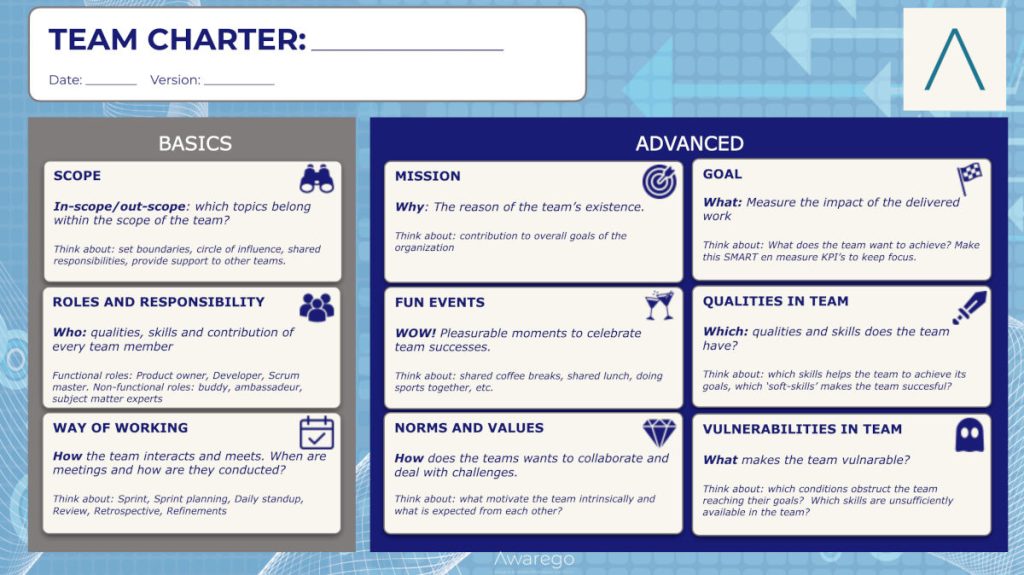
Creating a High-Performing Team: The Importance of a Team Charter
Author: Arthur Lankester
January 18nd, 2023
Tools: Team Charter Template (Powerpoint)
How a team charter helps to align towards a common purpose
A team charter is a document that outlines the purpose, goals and objectives of a team. It helps to align the team towards a common purpose and ensures that everyone is working towards the same goals. The purpose of a team charter is to provide a clear direction for the team, as well as a shared understanding of what is expected of each team member. This can help to increase productivity and improve team dynamics.
Having a team charter in place can help to prevent conflicts and misunderstandings within the team. It can also serve as a reference point for decision-making, as it clearly outlines the team’s goals and objectives. Additionally, a team charter can help to hold team members accountable for their actions, as it clearly defines each person’s roles and responsibilities.
The team charter should be a living document, it should be updated as necessary, for example when the goals of the team change, or when new members join the team, so that the team can continue to work effectively.
Key elements of a team charter, like mission statement and team goals
A team charter should include several key elements that will help to ensure the team is working towards a common purpose. These elements include:
- Mission statement: This should be a clear and concise statement that outlines the team’s overall purpose and goals.
- Team goals: These are specific, measurable, and time-bound objectives that the team is working towards.
- Scope: This clearly specify which topics belong within the scope of the team and which topics are considered not in scope of the team.
- Roles and responsibilities: A clear definition of the roles and responsibilities of each team member.
- Way of Working: A clear and agreed-upon process for how the team operates: team meetings, decision making, communication within the team and with stakeholders, measuring impact and KPI’s, etc.
- Norms and values: A shared understanding and co-created overview of team’s key values and expected behavior that enforces the key values.
- Qualities of the team: an explicit overview of skills available within the team to achieve its goals
- Vulnerabilities: A clear overview of conditions or lack of skills that can obstruct the team in achieving its goals.
It’s important to note that team charter should be created in a collaborative way, involving all team members, so that everyone has a sense of ownership and is invested in the success of the team. This will help to ensure that everyone is on the same page and working towards the same goals.

Creating a team charter to foster team development, performance and success
Creating a team charter involves involving all team members in the process and getting their buy-in. This can be done through a series of meetings or workshops where the team discusses their goals, objectives, and expectations. The following are some steps that can be taken to create a team charter:
- Define the scope of the team charter: Clearly define the scope of the team charter and what it will cover. This could include the team’s mission statement, goals, roles and responsibilities, and decision-making process.
- Involve all team members: Ensure that all team members are involved in the process of creating the team charter. This could include holding meetings or workshops where everyone can share their ideas and input.
- Develop a draft charter: Using the input from all team members, develop a draft charter that outlines the key elements such as mission statement, team goals, roles and responsibilities, and decision-making process.
- Review and revise: Once the draft charter is created, review it with the team and make revisions as needed. This could include incorporating feedback from team members and making sure that the charter is aligned with the team’s goals and objectives.
- Finalize the charter: Once the team charter is finalized, it should be communicated to all team members and made available for easy reference. It should also be reviewed and updated regularly to ensure that it stays aligned with the team’s goals and objectives.
Implementing a team charter, track progress and measure success
Implementing a team charter involves putting it into action and communicating it to the team. It also includes tracking progress and measuring success, as well as making adjustments as needed. The following are some steps that can be taken to implement a team charter:
- Communicate the charter to the team: Once the team charter is finalized, it should be communicated to all team members. This could include holding a meeting to discuss the charter and its key elements, as well as making it available for easy reference.
- Assign roles and responsibilities: Based on the roles and responsibilities outlined in the charter, assign specific tasks to team members. This will help ensure that everyone knows their role and how they contribute to the team’s success.
- Set clear goals and objectives: Based on the goals and objectives outlined in the charter, set specific and measurable targets for the team to achieve. This will help the team stay focused and aligned with the charter.
- Track progress and measure success: Regularly track the team’s progress and measure success against the goals and objectives outlined in the charter. This will help identify areas where the team is excelling, as well as areas where they need to improve.
- Make adjustments as needed: Based on the progress and success of the team, make adjustments to the charter as needed. This could include revising the mission statement, goals, or roles and responsibilities.
- Assign a team leader or facilitator: Assign a team leader or facilitator who will be responsible for ensuring that the team charter is implemented and followed.
- Establish a regular check-in: Establish a regular check-in or meeting schedule where the team will review and discuss the charter, progress, and any issues that may arise.
- Make sure to communicate any updates or changes to the team and make the charter easily accessible for reference
Conclusion
In conclusion, a team charter is an essential tool for team development and success. It helps to align the team towards a common purpose, goals and objectives, and defines the roles and responsibilities of each team member. Creating a team charter involves involving all team members in the process and getting their buy-in. Implementing a team charter is critical and involves putting it into action, communicating it to the team, tracking progress and measuring success, and making adjustments as needed. By using a team charter, teams can set a clear direction, increase productivity, and achieve their goals. It is important for teams to regularly review and update the charter to ensure that it stays aligned with the team’s goals and objectives.
To read more about Team charter you look this blog post on Easyretro. And are you interested in developing a team culture that improves business outcomes? Read this article about Building a DevOps culture that enhances business value.

MEET THE AUTHOR
Arthur Lankester
Arthur Lankester is a passionate trainer and coach helping individuals and organisations in developing ‘transformational capabilities’. Simply said, Arthur help’s people to develop skills to go through complex personal or organizational changes’. Arthur is graduated (Msc.) Psychologist and Master of Business Administration.
You can count on us!
Discover how you can consciously practice leadership, decision-making and encourage your team to do the same through our trainings. Contact us today so we can customise this e-learning resource to suit your needs.
Add your email to the mailing list to get the latest updates.
Join Our Community
Stories
- Culture 4
- E-learning 1
- Leadership 4
- Personal development 2
- Transformation 5
- Vertical development 1





